|
Tiger
Moth Flight
by Brett
Green
|
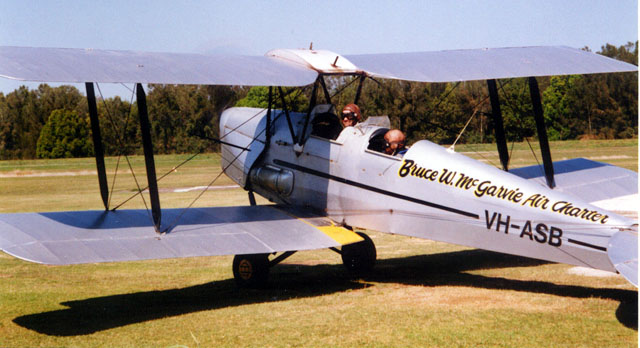
|
Tiger
Moth
VH-ASB |
I pull the rental car off the main road, crossing an old drag racing strip.
As the red VW rolls down the dirt track I see a few buildings and a large grass
paddock ahead. A silver Tiger Moth waits patiently in the sunshine.
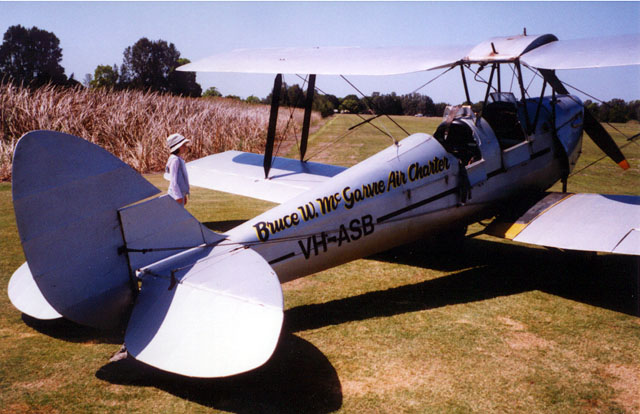
Surfers' Paradise is an area peppered with theme parks and pre-packaged
holiday attractions, "Bruce W. McGarvie Air Charter" stands out as
different. This is no slick tourist operation.
With the rental car parked in a shady spot I walk across a small covered
courtyard into the airstrip office. I am twenty minutes early for my flight and
find myself alone in the building. The back wall is plastered with yellowing
newspaper clippings - famous passengers, stories of a son and other relatives,
new aircraft acquisitions. Three leather flying helmets, goggles and jackets
hang in front of the counter. An adjoining room reveals glimpses of aircraft
parts
"We're just getting ready mate. You're early", shouts an
overall-clad crew member from the front door.
"No worries" I reply, "I'll have a look around". I am
pleased to spend some time absorbing the atmosphere of history and engine oil.
Outside, another staff member walks over to the aircraft with a large
battery. He spends a few minutes with his head buried in the front cockpit.
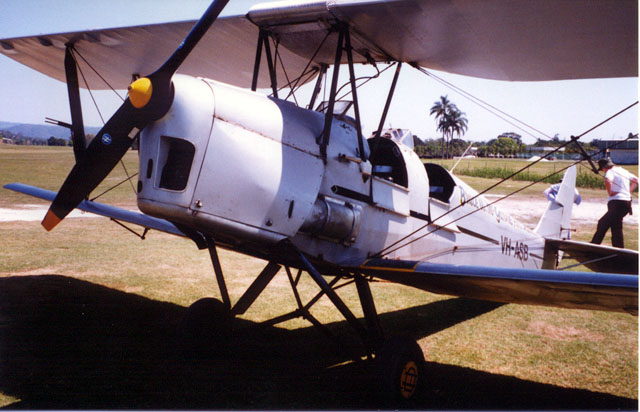
Crew member No. 1 returns. "Its pretty warm. Steve reckons you won't
need a jacket up there. Okay?". I agree and take the leather flying helmet
offered to me. "Here, I'll adjust that helmet for you".
We emerge into the sunshine and Steve, the pilot, walks over. Without
preamble, he says "Okay, lets go".
In our short walk across the grass, Steve advises the correct technique for
entering the front cockpit. "Step straight up onto the black walkway. Hold
on to the struts on top of the cockpit - one in each hand - then step over the
side onto the seat with both feet. You can shuffle your feet forward and sit
down." So far, so good.
When seated I note that the control column and rudder pedals have been
removed. My brief briefing continues: "Let's get you in the harness".
Steve demonstrates and adjusts the five-point harness. He plugs in the tube
attached to my flying helmet. "That's so that I can talk to you. There's a
tube under here" he continues, reaching under the instrument coaming to
reveal a narrow rubber cone, "so that you can talk to me in flight".
"You want to bring a camera with you?"
I mentally kick myself for not thinking of bringing any of my cameras on
vacation with me. This flight was an unplanned addendum to our family holiday
activities. I borrow my daughter's cheap instamatic - better than nothing I
suppose. Steve jumps down from the lower wing and walks around to the front of
the aircraft. With a single energetic turn of the propeller, the Gypsy Major
engine splutters into life. Steve removes the chocks and climbs into the rear
cockpit. Without further ceremony the throttle is opened, the plane moves
forward and swings toward the open grass paddock. The nose-up attitude of the
taxiing Moth means that Steve has to stick his head out the side for a decent
forward view.
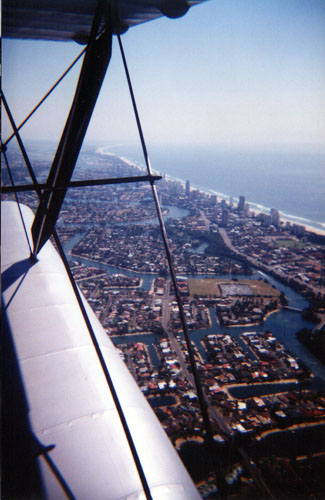 The
Tiger Moth taxies smoothly to the eastern end of the paddock. Almost at
the boundary fence, Steve guns the engine and swings the little biplane
hard to port. In an instant the tail has lifted, giving a good view of the
paddock in front. Another blink and we are airborne. The
Tiger Moth taxies smoothly to the eastern end of the paddock. Almost at
the boundary fence, Steve guns the engine and swings the little biplane
hard to port. In an instant the tail has lifted, giving a good view of the
paddock in front. Another blink and we are airborne.
I've been on plenty of jet airliners. It is hard not to be impressed by
their conquest of gravity by brute force as you are pushed into the back
of the plush seat, surrounded by TV screens and food and amenities.
Yet I found this simpler version of flying much more impressive. With
little more than a frame covered with fabric, this old biplane seemed to
work with nature rather than defy it.
As we lift gently into the sky, I am acutely aware of the breeze, the
sunshine, the occasional ripple of the air. It was a wonderful sensation,
more relaxing than exhilarating, but a great thrill nevertheless.
Steve banks the aircraft and heads east to the coast a few miles away.
My family waiting nervously below recede to specks and the magnificent
view of the Lamington Ranges to the west disappears over my shoulder. We
climb to an altitude of 1,000 feet and are cruising at around 80 knots.
Within a few minutes we are crossing the golden sands of Broadbeach.
The nose dips as we head a short distance out to sea. Heading north, we
have a magnificent view to port of the beaches and high-rise buildings of
the Gold Coast.
As we cruise north, a curious Cessna drops speed and forms up for a
close look. We fly at wingtip to wingtip for a few minutes until, with a
smile and a wave, he accelerates onward and upward. Steve takes this as a
cue, and climbs back to 1,000 feet while banking inland to complete a big
triangle. |
I take the opportunity to examine my surroundings in more detail. The
instrument panel is pretty basic. Not much more than altimeter, tachometer,
speedo, fuel gauge, oil pressure, amp meter and compass.

The tiny windscreen looks to be purely for show, but works well to protect
this passenger from the 80 knot breeze. I stick my hand out the side, away from
the sanctuary of the cockpit, and feel the surprising force of the wind even at
this sedate speed. Control rods move against my left leg as the aircraft is
adjusted for the new bearings. We fly over Sea World, and I can already see the
landmarks that will determine our return leg - shopping centres, lights of a
football stadium, artificial canals snaking around the suburbs of the Gold
Coast.
The final minutes of the flight slip quickly away and we are soon low on
approach to the eastern end of the paddock. Just before a barbed-wire fence,
Steve seems to cut the engine. The revs drop to almost zero. A sharp gust of
wind skews the little plane off centre, but Steve gracefully corrects the
problem before completing a perfectly smooth three-point landing. The engine
roars again briefly as the Tiger Moth taxies back to my waiting family. I turn
in my seat to see Steve's head stuck out the side of the cockpit to get a
forward view for the last few hundred feet of our journey.
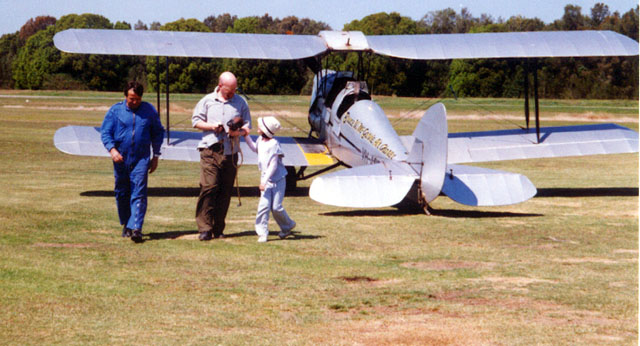
The twenty minutes from taxiing to my return has been full of unforgettable
sensations. It is fascinating to share the exact experience of pilots and
trainees from over 60 years ago. This twenty minutes has reminded me of what
flying is really about.
My flight cost me around $100 - money well spent for a rare journey in a
historic aircraft on a sparkling day. Marvellous!
"Tiger Moth Joy Rides" offers
scenic and aerobatic flights from Coomera Airstrip, opposite Dreamworld on
Australia's Gold Coast.
Telephone number for enquiries is +61 7 5502 7855
(from outside Australia) or 07 5502 7855 for Australian residents. Their website
may be found at
http://www.tigermothjoyrides.com.au
| A
d d i t i o n a l I m a g e s |
Click
on the thumbnail images below to view full sized.
Use the "Back" arrow on your browser to return to this page.
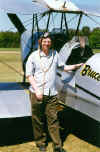


Text Copyright ©
2000 by Brett T. Green
Images Copyright ©
2000 by Brett and Debra Green
Page Created 10 October, 2000
Last Updated 08 April, 2004
Back to Reference Library
|
Home |
What's New |
Features |
Gallery |
Reviews |
Reference |
Forum |
Search